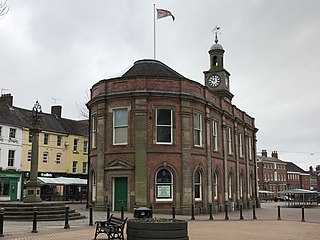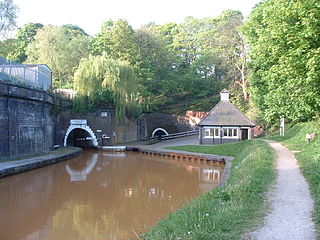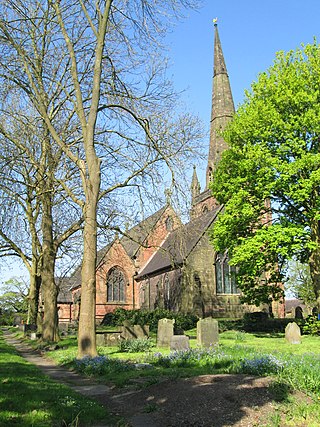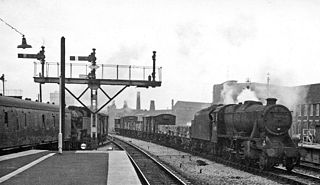
James Brindley was an English engineer. He was born in Tunstead, Derbyshire, and lived much of his life in Leek, Staffordshire, becoming one of the most notable engineers of the 18th century.

Newcastle-under-Lyme is a market town and the administrative centre of the Borough of Newcastle-under-Lyme in Staffordshire, England. The 2011 census population of the town was 75,082, whilst the wider borough had a population of 128,264 in 2016, up from 123,800 in the 2011 Census.

Kidsgrove is a town in the borough of Newcastle-under-Lyme, Staffordshire, England, on the Cheshire border. It is part of the Potteries Urban Area, along with Stoke-on-Trent and Newcastle-under-Lyme. It has a population of 26,276. Most of the town is in the Kidsgrove ward, whilst the western part is in Ravenscliffe.

The Borough of Newcastle-under-Lyme is a local government district with borough status in Staffordshire, England.

Tunstall is one of the six towns that, along with Burslem, Longton, Fenton, Hanley and Stoke-upon-Trent, amalgamated to form the City of Stoke-on-Trent in Staffordshire, England. It was one of the original six towns that federated to form the city. Tunstall is the most northern, and fourth largest town of the Potteries. It is situated in the very northwest of the city borough, with its north and west boundaries being the city limit. It stands on a ridge of land between Fowlea Brook to the west and Scotia Brook to the east, surrounded by old tile making and brick making sites, some of which date back to the Middle Ages.
Talke is a village in Staffordshire, England, 4 miles (6.4 km) northwest of Newcastle-under-Lyme and 1.5 miles (2.4 km) southwest of Kidsgrove. Population details taken at the 2011 census can be found under Kidsgrove.

Harecastle Tunnel is a canal tunnel on the Trent and Mersey Canal in Staffordshire between Kidsgrove and Tunstall. The tunnel, which is 1.6 mi (2.6 km) long, was once one of the longest in the country. Its industrial purpose was for the transport of coal to the kilns in the Staffordshire Potteries. The canal runs under the 195 m (640 ft) Harecastle Hill near Goldenhill, the highest district in Stoke-on-Trent.

Chesterton is a former mining village in the unparished area of Newcastle-under-Lyme, in the Newcastle-under-Lyme district, in Staffordshire, England.

Audley is a large village and former civil parish, now in the parish of Audley Rural, in the Newcastle-under-Lyme district, in Staffordshire, England. It is the centre of Audley Rural parish, approximately four miles north west of Newcastle-under-Lyme and 3 miles from Alsager near the Staffordshire-Cheshire border.
Wolstanton was a rural district in Staffordshire, England from 1894 to 1904. It was created by the Local Government Act 1894 based on Wolstanton rural sanitary district.

Wolstanton is a suburban town on the outskirts of Newcastle-under-Lyme, Staffordshire.

Clayton is a suburb and a ward in the south of Newcastle-under-Lyme, in the unparished area of Newcastle-under-Lyme, in the Newcastle-under-Lyme district, in the county of Staffordshire, England.
Basford is a suburb which sits on high ground between Newcastle-under-Lyme and Stoke-on-Trent in Staffordshire, England.
Kidsgrove Urban District was an urban district in the county of Staffordshire. It was formed in 1894 with the civil parishes of Hardings Wood, Kidsgrove, Newchapel and Talke. It was abolished in 1974, by virtue of the Local Government Act 1972, when it was absorbed into the Borough of Newcastle-under-Lyme.

The Potteries Loop Line was a railway line that connected Stoke-on-Trent to Mow Cop and Scholar Green via Hanley, Burslem, Tunstall and Kidsgrove. It ran between Staffordshire and Cheshire in England. It served three of the six towns of Stoke on Trent. It was opened in many short sections due to the cost of railway construction during the 1870s. The line throughout was sanctioned but the North Staffordshire Railway felt that the line would be unimportant enough to abandon part way through its construction. This upset residents of the towns through which the line was planned to pass and they eventually petitioned Parliament to force the completion of the route.

Turnhurst Hall was a substantial house which stood in an area of what is now Stoke-on-Trent, Staffordshire, England, between Great Chell and the hamlet of Newchapel in Newcastle-under-Lyme. The road linking the two settlements is now known as Turnhurst Road and the area where the former estate was located is now known as Turnhurst.
Hugh Henshall (1734–1816) was an English civil engineer, noted for his work on canals. He was born in North Staffordshire and was a student of the canal engineer James Brindley, who was also his brother-in-law.

Goldenhill is an area on the northern edge of Stoke-on-Trent, in the Stoke-on-Trent district, in the ceremonial county of Staffordshire, England. It is centred along the High Street, part of the A50 road that runs from south-east to north-west. It is about 1 mile (1.6 km) north of Tunstall and 1.5 miles (2.4 km) south-east of Kidsgrove.
Kidsgrove is a civil parish in the district of Newcastle-under-Lyme, Staffordshire, England. The parish contains 29 listed buildings that are recorded in the National Heritage List for England. All the listed buildings are designated at Grade II, the lowest of the three grades, which is applied to "buildings of national importance and special interest". The parish contains the town of Kidsgrove, The villages of Talke and Newchapel, and part of the village of Mow Cop. The Trent and Mersey Canal passes through the parish, and the listed buildings associated with it are bridges, tunnel portals, and a milepost. Also listed are three tunnel portals built by the North Staffordshire Railway. The other listed buildings include a village cross with a medieval base, houses and cottages, farmhouses and farm buildings, churches, a vicarage, a chapel with a manse, a memorial in a churchyard, a folly, a tower, and a war memorial.














